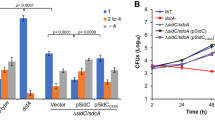Abstract
The BH3-only protein PUMA plays an important role in the activation of apoptosis in response to p53. In different studies, PUMA has been described to function by either directly activating the pro-apoptotic proteins Bax and Bak, or by neutralizing anti-apoptotic members of the Bcl2 family. We have examined the contribution of regions of PUMA other than the BH3 domain to its localization and function. Although the hydrophobic domain in the C-terminus of PUMA is necessary for efficient mitochondrial localization of PUMA itself, PUMA proteins lacking this region can still induce apoptosis and localize to the mitochondria through binding to Bcl2. Even a nuclear localization signal (NLS)-tagged PUMA protein retains apoptotic activity and can be efficiently relocalized from the nucleus after interaction with ectopically expressed Bcl2, underscoring the efficiency of this interaction. Interestingly, unlike the Bcl2 interaction, the binding of PUMA to Bax is severely compromised by the loss of the C-terminal domain of PUMA. However, since the loss of the C-terminus does not compromise the ability of PUMA to induce cell death, our results indicate that the key apoptotic function of PUMA is through interaction with anti-apoptotic proteins such as Bcl2.






Similar content being viewed by others
References
Hanahan D, Weinberg RA (2000) The hallmarks of cancer. Cell 100:57–70
Evan GI, Vousden KH (2001) Proliferation, cell cycle and apoptosis in cancer. Nature 411:342–348
Vogelstein B, Lane D, Levine AJ (2000) Surfing the p53 network. Nature 408:307–310
Hajra KM, Liu JR (2004) Apoptosome dysfunction in human cancer. Apoptosis 9:691–704
Cory S, Adams JM (2002) The Bcl2 family: regulators of the cellular life-or-death switch. Nat Rev Cancer 2:647–656
Puthalakath H, Strasser A (2002) Keeping killers on a tight leash: transcriptional and post-translational control of the pro-apoptotic activitive of BH3-only proteins. Cell Death Diff 9:505–512
Mihara M et al (2003) p53 has a direct apoptogenic role at the mitochondria. Mol Cell 11:577–590
Chipuk JE et al (2005) PUMA couples the nuclear and cytoplasmic proapoptotic function of p53. Science 309:1732–1735
Yee KS, Vousden KH (2005) Complicating the complexity of p53. Carcinogenesis 26:1317–1322
Vousden KH, Lu X (2002) Live or let die: the cell’s response to p53. Nat Rev Cancer 2:594–604
Nakano K, Vousden KH (2001) PUMA, a novel pro-apopototic gene, is induced by p53. Mol Cell 7:683–694
Yu J et al (2003) PUMA mediates the apoptotic response to p53 in colorectal cancer cells. Proc Natl Acad Sci USA 100:1931–1936
Jeffers JR et al (2003) Puma is an essential mediator of p53-dependent and -independent apoptotic pathways. Cancer Cell 4:321–3238
Villunger A. et al (2003) p53- and drug-induced apoptotic responses mediated by BH3-only proteins puma and noxa. Science 302:1036–1038
Hemann MT et al (2004) Suppression of tumorigenesis by the p53 target PUMA. Proc Natl Acad Sci USA 101:9333–9338
Letai A et al (2002) Distinctive BH3 domains either sensitize or activate mitochondrial apoptosis, serving as prototype cancer therapeutics. Cancer Cell 2:183–192
Chittenden T, (2002) BH3 domains: intracellular death-ligands critical for initiating apoptosis. Cancer Cell 2:165–166
Marani M et al (2002) Identification of novel isoforms of the BH3 domain proteins Bim which directly activate Bax to trigger apoptosis. Mol Cell Biol 22:3577–3589
Eskes R et al (2000) Bid induces the oligomerization and insertion of Bax into the outer mitochondrial membrane. Mol Cell Biol 20:929–935
Desagher S et al (1999) Bid-induced conformational change of Bax is responsible for mitochondrial cytochrome c release during apoptosis. J Cell Biol 144:891–901
Kuwana T et al (2005) BH3 domains of BH3-only proteins differentially regulate Bax-mediated mitochondrial membrane permeabilization both directly and indirectly. Mol Cell 17:525–535
Cartron PF et al (2004) The first alpha helix of Bax plays a necessary role in its ligand-induced activation by the BH3-only proteins Bid and PUMA. Mol Cell 16:807–818
Kim H et al (2006) Hierarchical regulation of mitochondrion-dependent apoptosis by BCL-2 subfamilies. Nat Cell Biol 8:1348–1358
Willis SN et al (2007) Apoptosis initiated when BH3 ligands engage multiple Bcl-2 homologs, not Bax or Bak. Science 315:856–859
Chen L et al (2005) Differential targeting of prosurvival Bcl-2 proteins by their BH3-only ligands allows complementary apoptotic function. Mol Cell 17:393–403
Willis SN et al (2005) Proapoptotic Bak is sequestered by Mcl-1 and Bcl-xL, but not Bcl-2, until displaced by BH3-only proteins. Genes Dev 19:1294–1305
Willis SN, Adams JM (2005) Life in the balance: how BH3-only proteins induce apoptosis. Curr Opin Cell Biol 17:617–625
Walensky LD et al (2004) Activation of apoptosis in vivo by a hydrocarbon-stapled BH3 helix. Science 305:1466–1470
Oltersdorf T et al (2005) An inhibitor of Bcl-2 family proteins induces regression of solid tumors. Nature 435:677–681
Morgenstern JP, Land H (1990) Advanced mammalian gene transfer: high titre retroviral vectors with multipledrug selection markers and a complementary helper-freee packaging cell line. Nuc Acids Res 18:3587–3596
Rowan S et al (1996) Specific loss of apoptotic but not cell cycle arrest function in a human tumour derived p53 mutant. EMBO J 15:827–838
Ray R et al (2000) BNIP3 heterodimerized with Bcl-2/Bcl-X(L) and induces cell death independent of a Bcl-2 homology 3 (BH3) domain at both mitochondrial and nonmitochondrial sites. J Biol Chem 275:1439–1448
Ke N, Godzik A, Reed JC (2001) BclB, a novel Bcl-2 family member that differentially binds and regulates Bax and Bak. J Biol Chem 276:12481–12484
U M et al (2001) Molecular cloning and characterization of six novel isoforms of human Bim, a member of the proapoptotic Bcl-2 family. FEBS Lett 509:135–141
Melino G et al (2004) p73 induces apoptosis via PUMA transactivation and Bax mitochondrial translocation. J Biol Chem 279: 8076–8083
Acknowledgements
We wish to thank Drs Eileen White and Wei-Xing Zong for the tBid and Bad plasmids, respectively. This work was funded by Cancer Research-UK and a generous fellowship from the West of Scotland Women’s Bowling Association, to support KSY.




